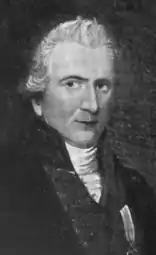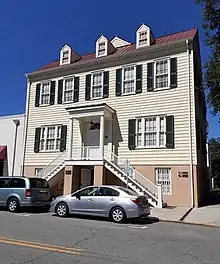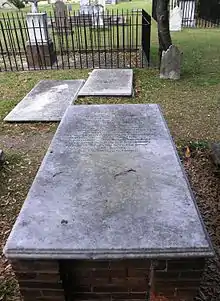John Berrien (major)
John Berrien (1759 – November 6, 1815) was a brigade major during the American Revolutionary War.
John Berrien | |
|---|---|
 Berrien around 1778 | |
| Born | 1759 |
| Died | November 6, 1815 (aged 55 or 56) Savannah, Georgia, U.S. |
| Resting place | Colonial Park Cemetery, Savannah, Georgia, U.S. |
| Nationality | American |
| Spouse(s) | Margaret Macpherson (1780–1785; her death) Williamina Sarah Moore (1790–1815; his death) |
Early life and career
Berrien was born in 1759 in Rocky Hill, New Jersey, to John Berrien and Lady Margaret Eaton (niece of Lord John Eaton of England).[1] His father, who was justice of the New Jersey Supreme Court,[2] died when John Jr. was thirteen. He moved to the Province of Georgia shortly thereafter, and stayed with his cousins, the LeContes.[3]
He joined the Continental Army at age 16, serving initially as one of General George Washington's aides. He was then commissioned as a second lieutenant in the Georgia Continental Brigade, under General Robert Ware, and also served in Florida. He served under General Lachlan McIntosh in 1777.[3] He distinguished himself in the Battle of Monmouth, while on Washington's staff, that he was complimented by the Second Continental Congress and made a brigade major at the age of eighteen.[1]


After the war, Berrien undertook privateering expeditions, during which he met Captain John Macpherson.[3] Macpherson built the opulent Mount Pleasant in Philadelphia around 1761.[4]
Berrien married Macpherson's daughter, Margaret, in 1780. They had one child, John Macpherson Berrien, who was born on August 23, 1781.[3]
On November 21, 1783, General George Washington wrote and delivered his farewell address at Rockingham, the former home of Berrien's father which Berrien Jr. had inherited.[5]
Shortly thereafter, Berrien returned to Georgia with his family, but Margaret died in McIntosh County in 1785.[3]
Berrien served as justice of the peace and captain of the militia while in Liberty County, Georgia.[3]
The Georgia legislature appointed him Collector of Customs at the Port of Savannah in 1786.[3]
In 1790, Berrien married a second time, to Williamina Sarah Moore (1771–1838), with whom he had seven more children:[6] Richard McAllister (1795), Ruth Lowndes (1798), Julia Maria (1801), Thomas, Sarah, Eliza and James Wemyss Moore (1807).[1]
In 1791, he built a house at today's 322–324 East Broughton Street in Savannah, Georgia.[7] He served again as Collector of Customs at the port, and was also an alderman between 1791 and 1795.[3]
Berrien was a member of Savannah's Christ Church. He was also an original member of the Society of Cincinnati, serving as president of the Georgia Society.[8] He was a member of Solomon's Lodge, the masonic lodge established by the colony of Georgia founder General James Oglethorpe.[3]
Berrien sold his Savannah home in 1797 after becoming the state treasurer in the new state capital of Louisville, Georgia.[3]
Death
Berrien died on November 6, 1815,[2] aged 55 or 56. He is interred in Savannah's Colonial Park Cemetery.[3] His second wife survived him by 23 years.
References
- Daughters of the American Revolution Magazine, Volume 52. National Society of the Daughters of the American Revolution. 1918. p. 652.
- "Major John Berrien". Georgia Historical Society. Retrieved 2022-04-04.
- "Berrien House Trust | Family History: Major John Berrien". berrienhouse.org. Retrieved 2022-04-04.
- "Mount Pleasant". Independence Hall Association.
- McFarlane, Kate E. (1912). "The Washington Headquarters at Rocky Hill". In Honeyman, A. Van Doren (ed.). Proceedings of the New Jersey Historical Society. Vol. I. pp. 85–90.
- Transactions of the Huguenot Society of South Carolina, Issue 84. Huguenot Society of South Carolina. 1979. p. 75.
- "Berrien House". The Georgia Trust. 2020-04-16. Retrieved 2022-04-04.
- "The Society of the Cincinnati in the State of Georgia – The Society of the Cincinnati in the State of Georgia". gasocietyofthecincinnati.org. Retrieved 2022-04-04.